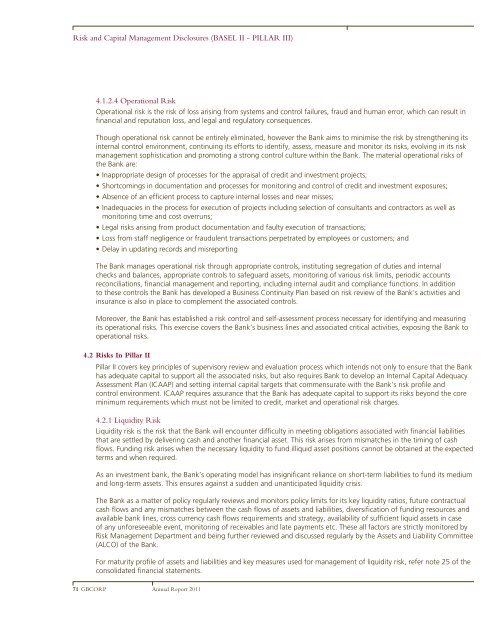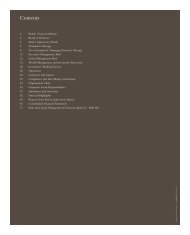GBCORP AR 2011 Basel II â Pillar III eng.pdf
GBCORP AR 2011 Basel II â Pillar III eng.pdf
GBCORP AR 2011 Basel II â Pillar III eng.pdf
Create successful ePaper yourself
Turn your PDF publications into a flip-book with our unique Google optimized e-Paper software.
Risk and Capital Management Disclosures (BASEL <strong>II</strong> - PILL<strong>AR</strong> <strong>II</strong>I)4.1.2.4 Operational RiskOperational risk is the risk of loss arising from systems and control failures, fraud and human error, which can result infinancial and reputation loss, and legal and regulatory consequences.Though operational risk cannot be entirely eliminated, however the Bank aims to minimise the risk by str<strong>eng</strong>thening itsinternal control environment, continuing its efforts to identify, assess, measure and monitor its risks, evolving in its riskmanagement sophistication and promoting a strong control culture within the Bank. The material operational risks ofthe Bank are:• Inappropriate design of processes for the appraisal of credit and investment projects;• Shortcomings in documentation and processes for monitoring and control of credit and investment exposures;• Absence of an efficient process to capture internal losses and near misses;• Inadequacies in the process for execution of projects including selection of consultants and contractors as well asmonitoring time and cost overruns;• Legal risks arising from product documentation and faulty execution of transactions;• Loss from staff negligence or fraudulent transactions perpetrated by employees or customers; and• Delay in updating records and misreportingThe Bank manages operational risk through appropriate controls, instituting segregation of duties and internalchecks and balances, appropriate controls to safeguard assets, monitoring of various risk limits, periodic accountsreconciliations, financial management and reporting, including internal audit and compliance functions. In additionto these controls the Bank has developed a Business Continuity Plan based on risk review of the Bank’s activities andinsurance is also in place to complement the associated controls.Moreover, the Bank has established a risk control and self-assessment process necessary for identifying and measuringits operational risks. This exercise covers the Bank’s business lines and associated critical activities, exposing the Bank tooperational risks.4.2 Risks In <strong>Pillar</strong> <strong>II</strong><strong>Pillar</strong> <strong>II</strong> covers key principles of supervisory review and evaluation process which intends not only to ensure that the Bankhas adequate capital to support all the associated risks, but also requires Bank to develop an Internal Capital AdequacyAssessment Plan (ICAAP) and setting internal capital targets that commensurate with the Bank’s risk profile andcontrol environment. ICAAP requires assurance that the Bank has adequate capital to support its risks beyond the coreminimum requirements which must not be limited to credit, market and operational risk charges.4.2.1 Liquidity RiskLiquidity risk is the risk that the Bank will encounter difficulty in meeting obligations associated with financial liabilitiesthat are settled by delivering cash and another financial asset. This risk arises from mismatches in the timing of cashflows. Funding risk arises when the necessary liquidity to fund illiquid asset positions cannot be obtained at the expectedterms and when required.As an investment bank, the Bank’s operating model has insignificant reliance on short-term liabilities to fund its mediumand long-term assets. This ensures against a sudden and unanticipated liquidity crisis.The Bank as a matter of policy regularly reviews and monitors policy limits for its key liquidity ratios, future contractualcash flows and any mismatches between the cash flows of assets and liabilities, diversification of funding resources andavailable bank lines, cross currency cash flows requirements and strategy, availability of sufficient liquid assets in caseof any unforeseeable event, monitoring of receivables and late payments etc. These all factors are strictly monitored byRisk Management Department and being further reviewed and discussed regularly by the Assets and Liability Committee(ALCO) of the Bank.For maturity profile of assets and liabilities and key measures used for management of liquidity risk, refer note 25 of theconsolidated financial statements.71 <strong>GBCORP</strong> Annual Report <strong>2011</strong>








